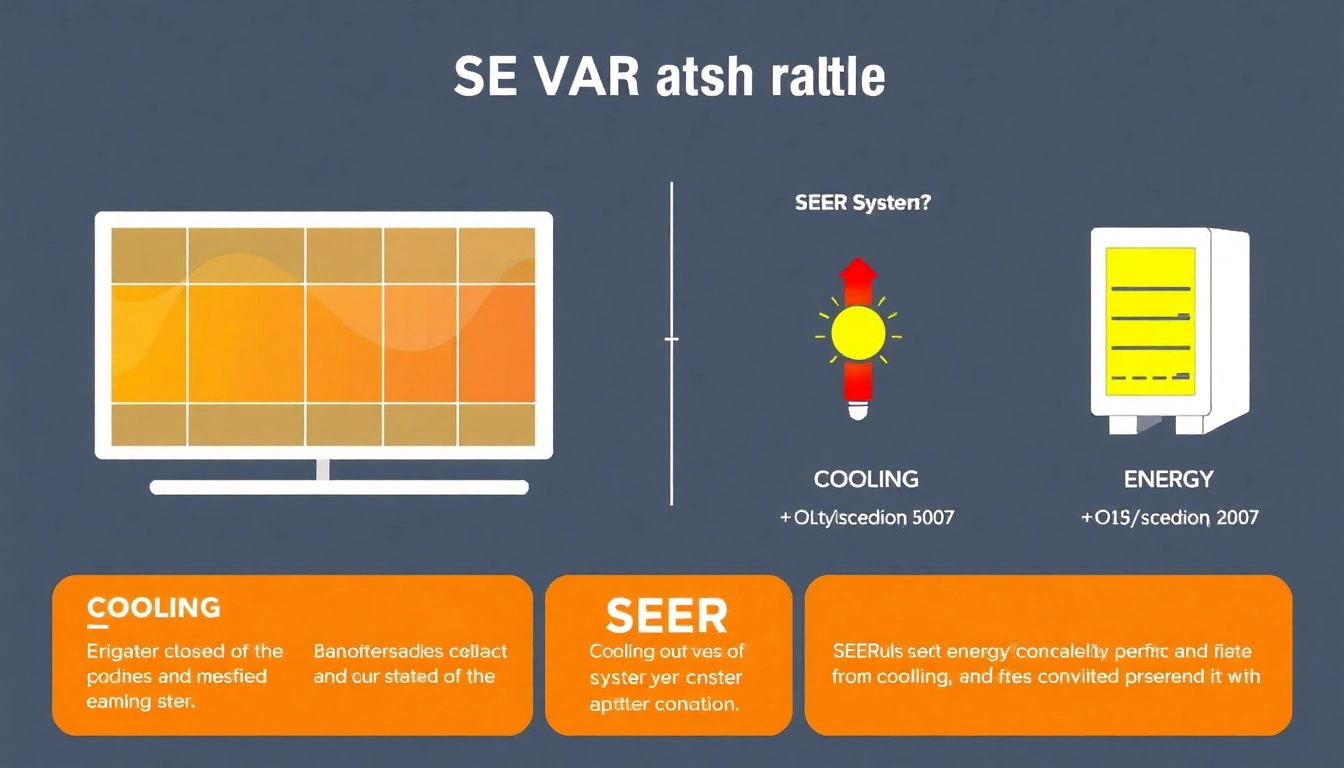What is SEER Rating in HVAC?
In today’s world, understanding the efficiency of heating, ventilation, and air conditioning (HVAC) systems is essential for homeowners and business owners alike. One of the key metrics you often hear about when discussing the efficiency of air conditioners and heat pumps is the SEER rating. This article will thoroughly explain the intricacies of SEER ratings, diving deep into their importance, how they are calculated, and what they mean for you as a potential consumer. You’ll learn everything from the basic definition to complex calculations, ensuring you’re well-informed. For detailed inquiries into HVAC systems and energy efficiency, you can find valuable resources at what is seer rating in hvac.
Definition of SEER Rating
SEER stands for Seasonal Energy Efficiency Ratio. It is a measure that expresses the efficiency of cooling systems such as air conditioners and heat pumps. The SEER rating is essentially the ratio of the cooling output (measured in British Thermal Units, or BTUs) divided by the amount of energy consumed (measured in Watt-Hours) over a typical cooling season. This metric is critical as it represents how effectively an HVAC unit can cool a designated space, reflecting its operational efficiency.
How SEER is Calculated
The calculation of SEER involves a few fundamental components. To arrive at the SEER rating, you start with the total cooling output in BTUs that a system produces during a standard cooling season. This includes the entire operation period, accounting for variations in temperature and conditions. The formula can be simplified as:
SEER = Total Cooling Output (BTUs) / Total Energy Consumption (Watt-Hours)
As an example, if an air conditioning system produces 30,000 BTUs over a cooling season while consuming 2,500 Watt-Hours, the SEER would be:
SEER = 30,000 BTUs / 2,500 Watt-Hours = 12
Higher SEER ratings indicate more efficient systems, which consume less energy to provide the same cooling output.
Importance of SEER Rating
The SEER rating serves as a vital benchmark for both consumers and manufacturers when it comes to air conditioning systems. A higher SEER rating often translates into better energy efficiency, which can lead to significant savings in energy costs over time. Selecting an air conditioning unit with a high SEER rating can greatly reduce utility bills, especially in climates where cooling is necessary for extended periods. Furthermore, with rising energy costs and growing environmental awareness, consumers are increasingly prioritizing energy efficiency.
Benefits of High SEER Ratings
Energy Efficiency and Cost Savings
Investing in HVAC systems with high SEER ratings offers considerable financial benefits. For instance, units with a SEER rating of 16 or higher are deemed high-efficiency systems. While these units may have a higher upfront cost, the energy savings accrued over the lifetime of the equipment often more than compensate for this expense. A general rule of thumb suggests that for every point increase in SEER rating, you can save approximately 10%-15% on cooling costs. This significant reduction can result in hundreds of dollars in savings annually depending on your locality and system usage.
Environmental Impact of High SEER Systems
In addition to personal cost savings, selecting high-SEER rated HVAC systems contributes positively to the environment. These systems are more energy-efficient, which means they consume less electricity, thus reducing demand on power plants and decreasing greenhouse gas emissions. By opting for equipment with higher SEER ratings, homeowners and businesses can directly contribute to reduced carbon footprints and a greener environment.
Comparison Between SEER Ratings
When comparing different air conditioning units, examining their SEER ratings is crucial. For example, a standard older model might have a SEER rating of 10, while newer units can reach SEER ratings over 20. Conducting a cost-benefit analysis between different SEER levels is essential to understand potential energy savings. Higher SEER systems are not only more efficient but often include advancements in technology, leading to better performance and longer lifespans.
Choosing the Right SEER Rating for Your Home
Factors to Consider When Selecting HVAC
Selecting the appropriate SEER rating for your HVAC system involves understanding various factors, including local climate conditions, home insulation quality, and the size of your living space. In hotter climates, a higher SEER rating is beneficial and may be essential, as air-conditioning systems work harder. For milder climates, a lower SEER system may suffice. Additionally, proper installation and maintaining your HVAC system can significantly affect its efficiency, regardless of the SEER rating.
Local Climate and Its Influence
Local climate plays a significant role in determining the necessary SEER rating for optimal performance. Residents in areas with longer and hotter summers would benefit from a system with a higher SEER rating. Conversely, homes in cooler climates may require a lower SEER rating as less cooling is required throughout the year. Understanding your specific weather patterns can help guide your decision. Utilizing tools such as energy calculators can help assess potential savings based on the expected cooling load.
Future-Proofing Your AC System
Thinking long-term, investing in a higher SEER rated system may be beneficial for future energy standards. As regulations become stricter and energy efficiency expectations increase, having a system that meets or exceeds future guidelines can save replacement costs and ensure compliance. Moreover, a dependable air conditioning system reduces the likelihood of breakdowns and the need for costly emergency replacements.
Common Misconceptions About SEER Ratings
SEER Ratings and Performance Myths
Despite the importance of SEER ratings, several misconceptions persist. One common myth is that a higher SEER rating automatically equates to superior comfort. While a SEER rating indicates energy efficiency, it does not directly correlate with temperature consistency or airflow quality. Various factors, such as ductwork, thermostat settings, and system design, also influence comfort levels. A well-balanced and properly sized system often performs better in terms of comfort than a system with a higher SEER rating but inadequate installation.
How SEER Relates to Comfort Levels
Many consumers mistakenly believe that a higher SEER rating guarantees that an air conditioning system can cool their home more effectively. While it is true that higher ratings symbolically represent efficiency, comfort is derived from many other components such as the system’s design and how well it is matched to your home’s cooling needs. Therefore, proper sizing and installation should not be overlooked when considering SEER ratings.
Understanding SEER in the Context of HVAC Systems
It is also essential to understand that SEER ratings can vary among different types of HVAC systems. For example, heat pumps have unique SEER ratings compared to traditional air conditioning units. You may also encounter terms like EER (Energy Efficiency Ratio) and HSPF (Heating Seasonal Performance Factor) used to gauge efficiency in different scenarios. Recognizing these distinctions ensures an informed decision when considering your specific needs.
Future of SEER Ratings: Changes and Regulations
Introduction of SEER2 Ratings
Recently, a new standard known as SEER2 has been introduced to further enhance the way SEER is calculated. This new system employs enhanced testing procedures that reflect real-world performance more accurately compared to the previous methods. SEER2 addresses previous discrepancies in efficiency estimations, therefore providing consumers with better insights into energy consumption and expected costs. It represents a significant upgrade from traditional SEER calculations, aiming to improve transparency and reliability.
Impact of Regulations on HVAC Technologies
As governments implement stricter energy efficiency regulations, manufacturers are increasingly designing new units that meet higher SEER standards. This not only helps in complying with environmental regulations but also pushes innovation within the HVAC industry. It’s crucial to stay updated on local regulations as they can influence both the selection process and the type of HVAC systems available. Understanding these regulatory changes allows consumers to choose systems that not only meet their needs but also contribute to a sustainable future.
Predictions for Energy Efficiency Standards
The future of energy efficiency standards is likely to see continuous evolution. Experts predict that as environmental concerns intensify and energy costs fluctuate, consumers will demand even more efficient systems. This shift will likely lead to advancements in technology, enabling HVAC manufacturers to produce unit models with even higher SEER ratings. By embracing and adapting to these changes, consumers can enjoy the benefits of cutting-edge technology while reducing their overall energy consumption.



